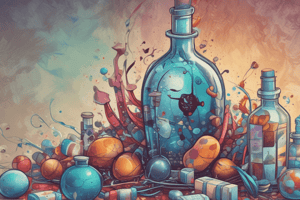Podcast
Questions and Answers
What process involves the engulfment of a drug molecule by the cell membrane?
What process involves the engulfment of a drug molecule by the cell membrane?
- Filtration
- Diffusion
- Exocytosis
- Endocytosis (correct)
What is primarily transported across the gut wall by endocytosis?
What is primarily transported across the gut wall by endocytosis?
- Amino Acids
- Vitamin B (correct)
- Electrolytes
- Sugars
Which of these is a key factor in drug distribution?
Which of these is a key factor in drug distribution?
- Proteins synthesis
- Blood flow (correct)
- Cellular metabolism
- Enzyme activity
What describes the relationship between drugs and plasma proteins?
What describes the relationship between drugs and plasma proteins?
What happens to the bound fraction of a drug in the bloodstream?
What happens to the bound fraction of a drug in the bloodstream?
What does pharmacodynamics primarily focus on?
What does pharmacodynamics primarily focus on?
Which process allows a drug to enter the bloodstream after administration?
Which process allows a drug to enter the bloodstream after administration?
Which of the following best describes pharmacokinetics?
Which of the following best describes pharmacokinetics?
What is meant by the term 'distribution' in pharmacokinetics?
What is meant by the term 'distribution' in pharmacokinetics?
In pharmacology, what is the primary focus of pharmacology as a field?
In pharmacology, what is the primary focus of pharmacology as a field?
Flashcards are hidden until you start studying
Study Notes
Drug Distribution
- The process by which a drug reversibly leaves the bloodstream and enters the interstitium (extracellular fluid) and/or the cells of the tissues.
- Influenced by blood flow, protein binding, and the drug's physicochemical properties.
Drug Binding
- A fraction of most drugs binds reversibly to plasma proteins, mainly albumin.
- The bound fraction of the drug is not active, not filtered, not metabolized, and not excreted, representing a depot form.
Pharmacology
- Pharmacology is the study of drugs, their sources, biochemical and physiological effects, mechanisms of action, and therapeutic uses.
- It comprises two main branches: pharmacokinetics (what the body does to the drug) and pharmacodynamics (what the drug does to the body).
- Pharmacokinetics involves four main processes: absorption, distribution, metabolism, and excretion (ADME).
Absorption
- The transfer of a drug from its site of administration to the bloodstream.
- It occurs from a region of low drug concentration to one of higher concentration.
- Factors influencing absorption include: concentration gradient, carrier proteins, energy requirements, and endocytosis for exceptionally large drugs.
Distribution
- After absorption, the drug reversibly leaves the bloodstream and distributes into the interstitial and intracellular fluids.
Metabolism
- The process by which the body chemically modifies drugs, primarily in the liver.
- Involves two phases:
- Phase I reactions include oxidation, reduction, and hydrolysis.
- Phase II reactions involve conjugation with sulfate, glycine, or glucuronic acid.
Factors Affecting Hepatic Microsomal Enzyme Activity
- Hepatic microsomal enzyme inducers increase the metabolism of other drugs, potentially shortening their duration of action.
- Examples include phenytoin, testosterone, cortisol, and tobacco smoking.
- Enzyme inducers can lead to a decrease in the effectiveness of drugs like oral anticoagulants, oral hypoglycemics, and oral contraceptives.
Studying That Suits You
Use AI to generate personalized quizzes and flashcards to suit your learning preferences.




